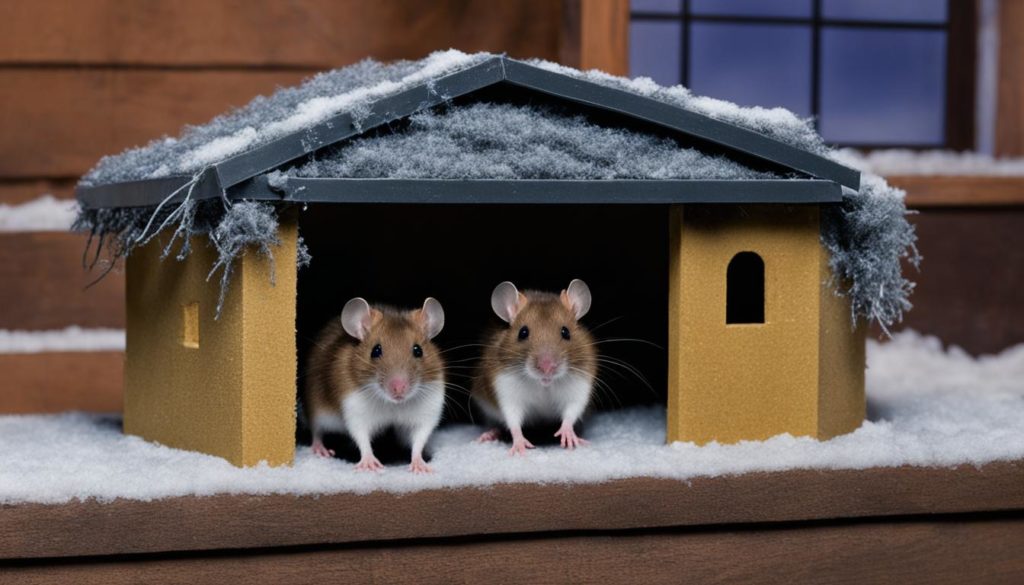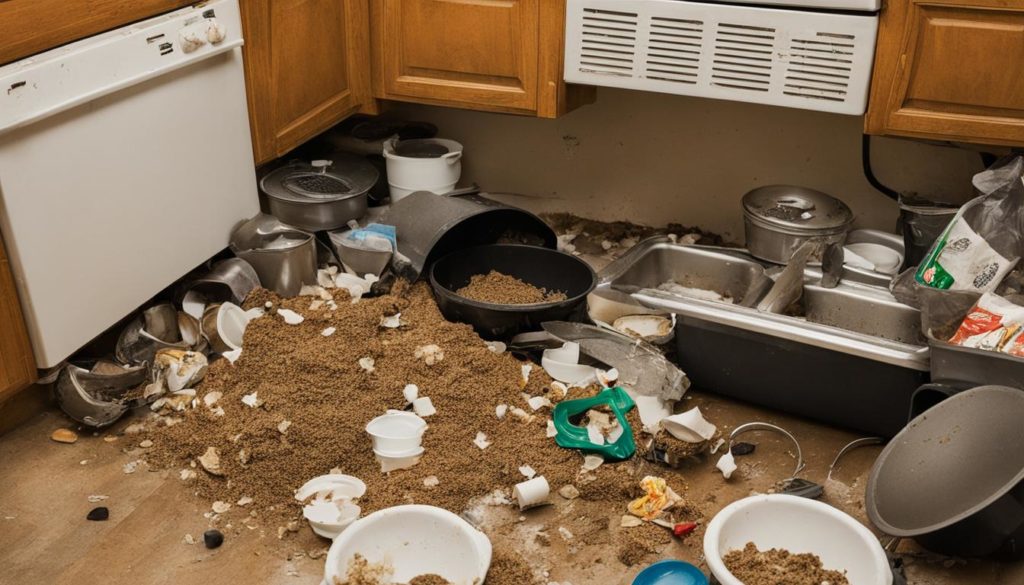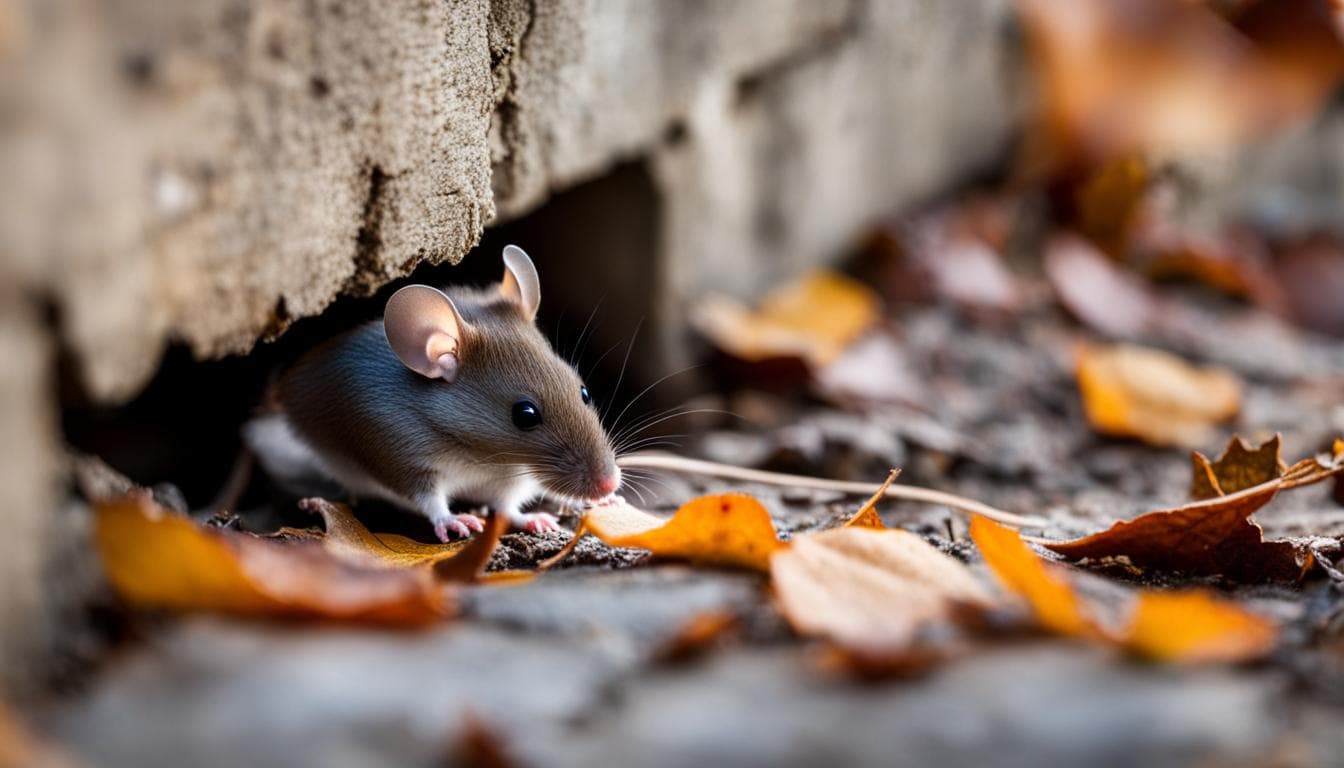As the seasons change and temperatures drop, homeowners may find themselves dealing with a common problem: mouse infestations. Understanding the core reasons behind these seasonal infestations is crucial in effectively protecting your home. So, why do mice become more active during certain seasons?
Key Takeaways:
- The fall and winter climates drive mice indoors as they seek warm shelters to escape the chill.
- During the breeding phase in warmer months, mice multiply, leading to increased activity during the fall and winter.
- The availability of food sources and changes in natural habits can affect the migration patterns of rodents and their propensity to enter homes.
- The pandemic-induced shutdowns of eateries and businesses in 2020 contributed to a rise in rodent activity.
- Understanding these seasonal patterns is essential to effectively prevent and address mouse infestations.
Understanding Mouse Behavior
Mice are fascinating creatures that exhibit unique behaviors in response to seasonal changes. By understanding their behavior patterns, we can gain insight into the signs of mouse infestations during different seasons and effectively address them.
Mice tend to breed during the warmer months and seek out warmer habitats during the colder months. They are known to enter homes and other structures to escape the harsh outdoor conditions.
Different seasons can have varying impacts on mouse behavior and activity. During the fall and winter, mice become more active indoors as they search for food sources and shelter from the cold. This increased activity can lead to higher chances of infestation if precautions are not taken.
Signs of Mouse Infestations during Different Seasons:
- Droppings: Look for small, cylindrical droppings resembling grains of rice. Fresh droppings are darker in color.
- Gnaw Marks: Check for irregularly shaped gnaw marks on food packaging, furniture, or other items. Mice constantly gnaw to keep their teeth trimmed.
- Evidence of Nesting: Look for shredded materials, such as paper or fabric, in hidden corners, attics, or crawl spaces.
- Unusual Noises: Listen for squeaking, scratching, or scurrying sounds, especially at night when mice are most active.
- Distinct Odor: Mice emit a strong, musky odor that intensifies with the increasing number of individuals in an infestation.
Being vigilant and recognizing these signs during different seasons can help you identify and address mouse infestations in a timely manner, preventing further damage to your property and potential health risks.
Prevention Tips for Seasonal Mouse Problems

To prevent mouse infestations, it’s important to take proactive measures to make your home less attractive to these pests. By addressing the common causes of mouse infestations and implementing preventive strategies, you can protect your home from seasonal mouse problems and ensure a pest-free living environment.
Identifying Common Causes of Mouse Infestations
Mouse infestations can often be traced back to specific factors that make your home appealing to these rodents. Understanding these common causes can help you take targeted steps to prevent infestations:
- Food Sources: Mice are attracted to accessible food sources, such as uncovered garbage bins, pet food left out overnight, or crumbs and spills on the kitchen floor. Proper food storage and regular cleaning can help eliminate these attractive food sources.
- Water Sources: Mice require water for survival, so any areas of excess moisture in your home can attract them. Leaking pipes, dripping faucets, or water accumulation in basements should be promptly addressed.
- Entry Points: Mice can squeeze through small openings in your home’s exterior, such as cracks in the foundation, gaps around doors and windows, or utility penetrations. Sealing these entry points with caulk or other appropriate materials can prevent mice from entering your home.
- Nesting Opportunities: Cluttered and untidy areas provide mice with suitable nesting sites. Dispose of unnecessary items, organize storage areas, and declutter your home to eliminate potential nesting opportunities for mice.
Prevention Tips for Seasonal Mouse Problems
Now that you’re aware of the common causes of mouse infestations, it’s time to implement preventive measures to protect your home. Follow these tips to prevent seasonal mouse problems:
- Seal Entry Points: Inspect the exterior of your home for any openings that mice can use to enter. Seal gaps and cracks with caulk or steel wool to prevent their access.
- Eliminate Food Sources: Store food in airtight containers, clean up spills and crumbs promptly, and ensure trash bins are covered tightly. Denying mice easy access to food will discourage them from entering your home.
- Remove Water Sources: Fix any leaks or dripping faucets in and around your home to eliminate water sources that can attract mice.
- Keep a Tidy Home: Regularly declutter, clean, and organize your home to minimize nesting opportunities for mice. Pay attention to areas like basements, attics, and storage spaces.
- Use Mouse Deterrents: Consider using natural deterrents like peppermint oil, mothballs, or ultrasonic devices to repel mice from your home.
By implementing these prevention tips, you can greatly reduce the risk of seasonal mouse infestations and protect your home from these unwanted guests.
Dealing with Mouse Infestations in Different Seasons
If you find yourself dealing with a mouse infestation during different seasons, it’s important to take swift and effective action to eliminate the problem. Mice can quickly reproduce and cause extensive damage to your home, so addressing the infestation promptly is crucial.
A first line of defense against mouse infestations in any season is the use of traps and repellents. Traps, such as snap traps or live traps, can be strategically placed in areas where mice are commonly found, such as near food sources or along their travel paths. It’s essential to choose the right type of trap and bait it properly to maximize its effectiveness. Repellents, such as peppermint oil or ultrasonic devices, can also be used to deter mice from entering your home.
However, if the infestation is severe or persistent, it’s advisable to seek professional rodent control services. Pest control experts have the knowledge, experience, and tools to effectively eliminate mouse infestations and provide long-lasting solutions. They can conduct a thorough inspection of your property, identify entry points, and implement targeted pest control measures to eradicate the infestation.
“It’s important to address mouse infestations in different seasons promptly to prevent damage to your home and ensure the health and safety of your family. Don’t hesitate to seek professional help if needed.”
Remember, mouse infestations can occur throughout the year, so it’s crucial to remain vigilant and take preventive measures to protect your home. Regularly inspect your property for potential entry points and seal them off. Keep your home clean and free from food debris, as this can attract mice. Store food in sealed containers and maintain a clutter-free environment to eliminate possible nesting sites.
Seasonal Mouse Infestation Prevention Checklist
Here’s a helpful checklist to prevent mouse infestations during different seasons:
- Seal off cracks, gaps, and holes in your home’s exterior, paying close attention to areas around pipes, vents, and utility lines.
- Install door sweeps and weatherstripping to prevent mice from entering through gaps under doors and windows.
- Trim tree branches and shrubs that are close to your home’s exterior to minimize potential entry points.
- Keep your home clean and well-maintained, removing clutter and ensuring proper sanitation.
- Store food in airtight containers and promptly clean up spills or crumbs.
- Regularly inspect your home for signs of mice, such as droppings, gnaw marks, or chewed wires.
By following these prevention tips and taking appropriate action, you can effectively tackle seasonal mouse infestations and protect your home from potential damage.
Factors Contributing to Seasonal Mouse Infestations

Seasonal mouse infestations are influenced by several factors that contribute to their occurrence. Understanding these factors can help homeowners take proactive steps in protecting their homes from these unwanted pests.
- Availability of Food Sources: During the fall and winter, food becomes scarcer in outdoor environments, prompting mice to search for indoor spaces where they can find a consistent food supply. The lack of food sources outdoors drives mice to invade homes and other structures in search of sustenance.
- Changes in Weather and Temperature: Extreme temperatures, heavy rainfall, and other weather anomalies can disrupt the natural habitats of mice. When their outdoor shelters are disturbed, mice are forced to seek alternative shelter, often finding their way into homes and buildings.
- Natural Breeding and Migration Patterns: Mice have natural breeding and migration patterns that influence their behavior throughout the year. They tend to breed during the warmer months and seek warm habitats during the colder months. As the seasons change, mice migrate in search of suitable shelters to escape the harsh outdoor conditions.
By recognizing these contributing factors, homeowners can better understand why and when mouse infestations are more likely to occur. This knowledge allows for the implementation of targeted preventive measures, effectively reducing the risk of seasonal mouse infestations.
Implementing measures such as sealing entry points, eliminating food and water sources, and maintaining proper sanitation can go a long way in preventing mice from entering and infesting homes.
“The availability of food sources, changes in weather and temperature, and the natural breeding and migration patterns of mice are all factors that contribute to seasonal mouse infestations.”
Conclusion
Seasonal mouse infestations can be a common problem for homeowners, especially during the fall and winter months. Understanding the core reasons for these infestations is key to tackling them effectively and protecting your home. Changes in weather, natural breeding patterns, and the availability of food sources all play a role in attracting mice to your living space.
To prevent mouse infestations, it’s important to take proactive measures. Start by sealing up entry points, such as gaps in windows and doors, to prevent mice from gaining easy access to your home. Decluttering and regularly cleaning your living areas can also reduce nesting opportunities for mice. Additionally, proper food storage in sealed containers can help eliminate potential food sources that may attract these pests.
If you find yourself dealing with a mouse infestation, especially a severe one, it’s best to seek professional rodent control services. They have the expertise and tools to effectively eliminate the problem and provide long-lasting solutions that protect your home. By taking these preventive measures and seeking professional help when needed, you can ensure the safety and comfort of your living space year-round, free from seasonal mouse infestations.
FAQ
Why do mouse infestations occur more frequently during certain seasons?
Seasonal mouse infestations occur due to a combination of factors, such as changes in weather and temperature, natural breeding and migration patterns, and the availability of food sources. Mice tend to seek out warmer habitats during the colder months, leading them to enter homes and other structures for shelter. When food becomes scarce in outdoor environments, mice are more likely to search for indoor spaces with a consistent food supply.
What are the signs of a mouse infestation during different seasons?
The signs of a mouse infestation can vary depending on the season. During the fall and winter, you may notice an increase in mouse activity indoors, as they search for food sources and shelter from the cold. Look out for signs such as droppings, gnaw marks, and evidence of nesting to identify and address mouse infestations in a timely manner.
How can I prevent seasonal mouse problems in my home?
To prevent mouse infestations, it’s important to make your home less attractive to these pests. Common causes of mouse infestations include food and water sources, entry points, and nesting opportunities. To prevent seasonal mouse problems, seal up entry points, declutter your home, store food properly, and maintain cleanliness and hygiene.
How do I deal with mouse infestations in different seasons?
If you find yourself dealing with a mouse infestation during different seasons, it’s important to take swift and effective action. Depending on the severity of the infestation, you can try using traps and repellents as a first line of defense. Professional rodent control services can provide comprehensive and long-lasting solutions for severe infestations.
What factors contribute to seasonal mouse infestations?
Seasonal mouse infestations are influenced by various factors. These include the availability of food sources, changes in weather and temperature, and the natural breeding and migration patterns of mice. As food becomes scarcer in outdoor environments during the fall and winter, mice are more likely to seek out indoor spaces for a consistent food supply and shelter from the cold.
How can I effectively protect my home from seasonal mouse infestations?
To effectively protect your home from seasonal mouse infestations, it’s important to understand the core reasons for these infestations. By implementing preventive measures such as sealing up entry points, decluttering, proper food storage, and maintaining cleanliness, you can significantly reduce the risk of infestations. In cases of severe infestations, seeking professional rodent control services can provide effective and long-lasting solutions.
Source Links
- https://www.excelpestservices.com/rats-and-mice-a-complete-guide/
- https://proofpest.com/rodent-season
- https://www.trulynolen.ca/location/milton/blog/milton-pest-control-3-things-you-didnt-know-mice-love/

Welcome to micegoneguide.com, your go-to resource for eliminating rats and mice. Say goodbye to rodent infestations with our expert tips and strategies. Visit us now and reclaim your space!

